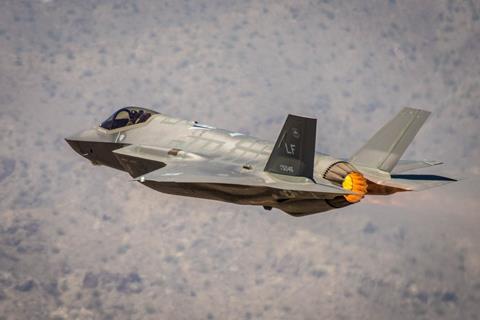GE Aerospace is continuing to press the US Air Force (USAF) to procure a new powerplant for Lockheed Martin’s F-35 fifth-generation fighter, rather than opting to perform core upgrades on the type’s existing powerplant.
The push comes ahead of the expected release in March of US President Joe Biden’s fiscal year 2024 budget proposal – a document that could reveal the Pentagon’s plans for addressing shortfalls with the F-35’s existing, Pratt & Whitney-made F135 powerplant.
GE developed its XA100 adaptive-cycle engine for the F-35 under the USAF’s Adaptive Engine Transition Program (AETP), saying the powerplant provides “transformational benefits” in range, thrust, acceleration and fuel consumption.

“We really think AETP clearly is the solution. And we are ready to meet that challenge and continue to move forward,” David Tweedie, general manager of GE Edison Works, said on 16 February. Edison Works is GE Aerospace’s advanced technology development division.
The prototype XA100 powerplant is designed to combine the power and thrust of a traditional fighter engine with the fuel efficiency of a commercial jet turbine.
Raytheon subsidiary P&W also developed an adaptive F-35 engine under AETP called the XA101.
The USAF commissioned the adaptive engine development programme to address growing concern about the single-engined F-35’s power supply – namely that it does not have enough.
There have been substantial advances to the F-35’s radar, electronic warfare modules and other sensors in the roughly 20 years since Lockheed and P&W designed the aircraft and engine. Those electronics come with power and cooling demands beyond what the F135 was intended to provide.
However, more than six years after it issued AETP contracts in 2016, whether the USAF will actually field one of the adaptive engines designed to solve that power and cooling shortfall remains a matter of debate in Washington.
While GE has pushed for the adoption of its adaptive engine, P&W has pursued an alternative tack by developing a core upgrade package for the existing F135 powerplant. The company argues its Engine Core Upgrade (ECU), formerly known as the Enhanced Engine Package, will solve the power issue more quickly and at a much lower cost than a full replacement.
“Upgrades like this are a normal part of any major defence programme, and the F135 engine has been pushed beyond its original specifications for too long,” says Jill Albertelli, president of P&W’s military engines business.
P&W describes the ECU as the “lowest-risk” path to upgrading the F-35’s propulsion, as the package uses the original engine with which the jet was flight-tested.
“Pratt & Whitney is offering the [ECU] because it solves the problem and it does so in the most cost-effective way,” says Jennifer Latka, vice-president of F135 engines for P&W.
But GE argues its XA100 represents the superior choice for the USAF, both in terms of aircraft performance and reduced maintenance and sustainment costs.
“I think physics has shown for a while that incremental upgrades to existing engines cannot alone meet the actual needs of the war fighter,” says Tweedie.
“Only AETP solutions can provide the 30% range increase, the 20% kinematic capability improvements… [and] double thermal management capacity, as well as providing durability enhancements and readiness improvements,” he adds.
Tweedie says GE aims to “seamlessly integrate” XA100s into the USAF F-35A fleet, including sustainment support and full production of engines, by 2028.
Latka says P&W’s ECU could also enter service by that date.
An indicator of which way the USAF is leaning should come in March, when the Biden administration is expected to release its FY2024 budget request to the US Congress. But even the president’s blessing will be no assurance, as lawmakers, when drafting actual budgets, tend to favour their own priorities over those of the Pentagon and White House.
Both GE and P&W are claiming to have budgetary and bureaucratic momentum on their side.
P&W received a $115 million contract from the USAF last December to support “preliminary development activities” on the ECU programme. Following that award, Latka said the engine maker is proceeding as if the programme will be fully adopted.
“We are on contract for [engine core upgrade], and we are ramping it as if it is never going to stop,” she said in December, noting that P&W has 250 engineers working on the programme.
However, GE also received a supplemental contract from the USAF for its adaptive engine, according to Tweedie. He describes a $203 million award included in the FY2022 budget as “a contract extension to the AETP programme”.
The company had announced completion of its XA100 development objectives last September, when GE accomplished its last testing milestone for the USAF under its AETP contract.
Tweedie says the $203 million extension will allow GE to keep its XA100 production facilities and staff, which currently include 400 engineers, working while the USAF makes a decision about the F-35’s propulsion.
“The whole goal here is to ensure and protect our ability to seamlessly integrate… the platform into our supply base, and into the operations and sustainment ecosystem for the F-35 by 2028,” he explains.
Regardless of the USAF’s decision, both engine makers will have ample opportunity in the coming years to deploy the adaptive engine technologies matured under AETP.
Under a nearly $5 billion initiative known as Next Generation Adaptive Propulsion (NGAP), the USAF will provide up to $975 million each to GE, P&W, Boeing, Lockheed, and Northrop Grumman to fund research and development of adaptive propulsion systems for the USAF’s “future air-dominance platforms”.
The service confirms to FlightGlobal that NGAP will to power the secretive sixth-generation aircraft currently being developed by the USAF, known as the Next Generation Air Dominance system.


























